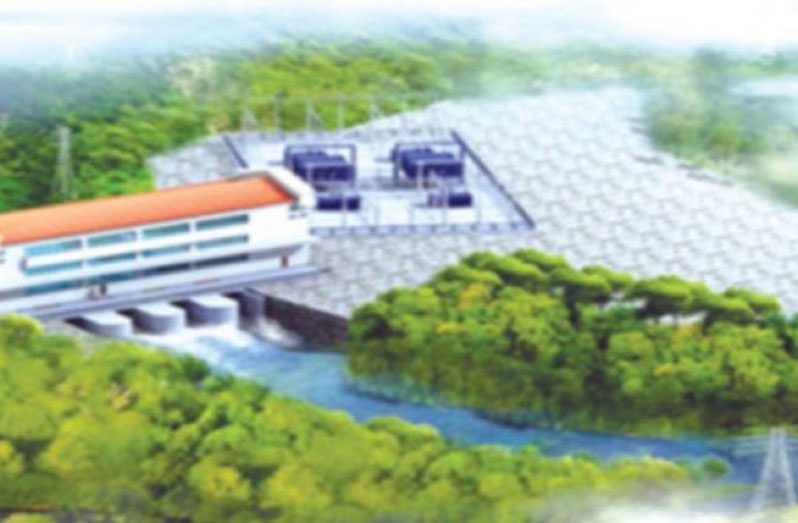GUYANA has an abundance of natural resource capacity which positions the country to tap into more renewable sources of energy, like from water or the sun, to meet its growing electricity demand.
The demand for electricity in Guyana is expected to triple by 2026 as the country develops its productive sectors such as manufacturing. This increased demand for electricity, however, will not be satisfied by the use of non-renewable energy sources.
President Dr. Irfaan Ali, at the launch of Guyana’s updated Low-Carbon Development Strategy (LCDS) last year, said that Guyana will meet the increased energy demand by integrating new renewable energy sources.
“Cheaper electricity will be supplied, and that supply can increase, five-fold, with emissions staying essentially flat,” the Head-of-State explained.
Emissions are harmful gases released when non-renewable energy sources like diesel are burnt to produce energy. Each year, millions are spent to import diesel to produce electricity at the Guyana Power and Light (GPL)’s power plants that supply electricity to the Demerara Berbice Interconnected System (DBIS), Guyana’s main power grid.
Diesel is made from refined crude oil. Though this crude oil is now being produced offshore Guyana, the president also said that Guyana is keen on exploiting the natural gas produced offshore, alongside the oil. Natural gas is believed to be “cleaner” than oil.
The use of natural gas, which will be produced at the forthcoming gas-to- energy project at Wales, on the West Bank of Demerara in Region Three (Essequibo Islands-West Demerara), is expected to complement the power that will be supplied through the renewable energy projects. More than $20 billion has been allocated to kick-start this project in 2022, and it should be completed by 2024.
The long-awaited and highly-anticipated renewable energy project is the People’s Progressive Party/Civic (PPP/C) Government’s Amaila Falls hydropower project.
This project was first identified in 1976 by the Canadian company, Monenco, during an extensive survey of hydroelectric power potential in Guyana. In 2009, this project was launched as part of Guyana’s efforts to pursue a more low-carbon future. Funds had been earmarked for this project, but it was subsequently voted down in the National Assembly.
REVIVED
Since assuming office in 2020, President Ali has assured the nation that this project, which is expected to drastically reduce the cost of electricity, will be revived.
In November 2021, China Railway Group Limited, a company that was initially selected to construct the massive Amaila Falls Hydropower Project in 2012, was once again granted approval to construct this massive renewable energy project.
And, the company will undertake all the building and operational costs, with the government only purchasing produced power to resell to consumers across Guyana. This project should be completed by 2025.
But the much-anticipated Amaila Falls Project is not the only hydropower project in the works, though, as two small hydropower plants are slated for construction at Kumu and Moco Moco, both of which communities are located in Region Nine (Upper Takutu-Upper Essequibo).
The proposed 1.5-megawatt (MW) hydropower plant at the Kumu River is expected to last 30 years, once a rigid maintenance programme is employed, while the Moco Moco facility will comprise an upgraded installed capacity of 700 kilowatts (KW).
These smaller projects in Region Nine are being pursued with assistance from the Islamic Development Bank (IsDB).
But, even with these projects, Guyana’s ‘green’ energy potential has not yet been exhausted, as some 30,000 households in hinterland and riverine communities across Guyana are expected to benefit from solar power through the government’s electrification programme.
As per the project proposal, each household is expected to have its own solar panel, an inverter, and basic fittings. This means that each household would be able to generate electricity on a self-dependent basis. The line-of-credit for this project was already been signed between Guyana and India.
Meanwhile, $1.1 billion has also been budgeted for solar farm interventions in 2022. These include the completion of the 1.5 MW solar farm at Bartica, the 0.75 MW one at Wakenaam and the 1.0 MW one at Lethem. Tenders for a 0.6 MW solar farm at Leguan and a 0.65 MW one at Mahdia will also be pursued.
With these renewable energy projects and more, President Ali said that the government anticipates that Guyana will eventually be able to phase out the use of about 70 per cent of non-renewable fossil fuels by 2027.
During a recent interview, Guyana’s Vice-President Dr. Bharrat Jagdeo posited that these renewable energy projects will help Guyana maintain a low-carbon status amid its oil production pursuits. In fact, he explained that these pursuits do not run counter to Guyana’s low-carbon development goals, since the country is showing the world that it can strike a balance in its energy development.




.png)









